![]()
On the afternoon of April 11th, 1905, roughly around 3.00pm – a rag and bone man by the name of David Shields was going around searching for unwanted items of rags and other wares he could go on to sell, when, after making his way along the backs of Hoyle Street within the Ardwick area of Manchester, he noticed the back door of number 24 open. As all of the houses on the street had been abandoned for some time, curiosity got the better of him. Making his way into the yard, he saw a sack and part of an egg box that had been left leaning against the wall of the house. Behind these items, there was a hole – around twenty inches by sixteen, that led directly into the cellar.
As he kneeled down, he peered into the abyss below and after a few seconds elapsed and his eyes had adjusted to the darkness, he slowly began to make out the form of a body lying on the floor which he took to be a man. As he clambered into the hole, he was horrified to see it wasn’t a man after all, but a young boy who had been maltreated in a most brutal manner.
Panic set in almost immediately. Shields quickly made his way out of the cellar and on his passing, he informed another rag and bone man by the name of Harris who was working close by. Both men then headed towards Fairfield Police Station which was situated only a matter of minutes’ walk away.
What Shields had uncovered that day would reignite the fears that had suffocated the East End of London during 1888 and what is now commonly known as the autumn of fear or as many know it, the Jack the Ripper murders.
Today’s story has been recommended to me by DAFT MONKEY, a Youtuber who creates content based on bringing history back to life. His videos cover many aspects of life in and around Salford during the Victorian era, bringing long lost and perhaps forgotten people and places back to the present, allowing them to tell their stories one more time. He films in a unique style and presents them in an honest and respectful way, so please check out DAFT MONKEY over on his Youtube channel as well as on Facebook, Twitter and Instagram. All the links can be found below.
Ardwick was without doubt one of the poorest areas of Manchester back in the early parts of the 1900’s and the houses, especially in and around Hoyle Street had been abandoned with many already demolished ready to make way for the extension of the nearby railway line.
And as was life in Edwardian England, and especially more so in the poorest areas, children were left to find their own way in life – working long hours from extremely young ages to living on the streets and facing up to daily beatings at the hands of strangers. And those that were lucky enough to still live with their parents, even then, poor living conditions contributed to high levels of abuse at the hands of the parents.
Thomas Smith was just 15 years old when he was last seen on the morning of April 4th 1905. His widowed mother being the last person to speak to him that we know of. It was around 5.30am when she caught him leaving their home, which was situated at number 16 Wood Street West in Chorlton-on-Medlock. Noticing he wasn’t holding his lunch and presuming he was setting off to go to work over at Greenhalgh and Hacklestone’s Works at nearby Bridgewater Street, she called him back to which he told her he wouldn’t be going into work until breakfast time that morning.
Thomas was a quiet boy and by all accounts he only had a few friends that his mother knew of. And as was recorded in the press at the time, he was a ‘delicate boy’ who couldn’t even go to sleep on his own at nights. Even his home life was said to have been comfortable as he shared his home with his older brother Isaac who was 30 years old, as well as a nephew.
Not thinking too much of it, Thomas’ mother waved him off, expecting him to return home later that morning to pick up his lunch. She would never see him alive again.
Obviously, when Thomas failed to return home later that morning, his mother would have been worried as to his whereabouts. At first she thought he may have travelled over to Denton or Dukinfield to visit either one of his sisters but her enquiries brought nothing. He hadn’t been seen in either of those areas. A couple of days passed and fraught with worry, Mrs. Smith sent her son, Isaac to the local police station where Thomas was officially reported as missing.
However, the day after his disappearance, two boys whom had worked with Thomas over on Bridgewater Street called at his home, asking his mother if he was going into work that morning. She sent them back with a message that Thomas was sick but would be returning back to work the following morning as she didn’t want Thomas to return home only to find out he had been dismissed for failing to show up at work.
Despite her searching and even after informing the police of Thomas’s disappearance, nothing was seen or heard of him until the discoverer of a body of a young boy on Tuesday, April 11th – exactly one week after his disappearance.

Thomas Smith 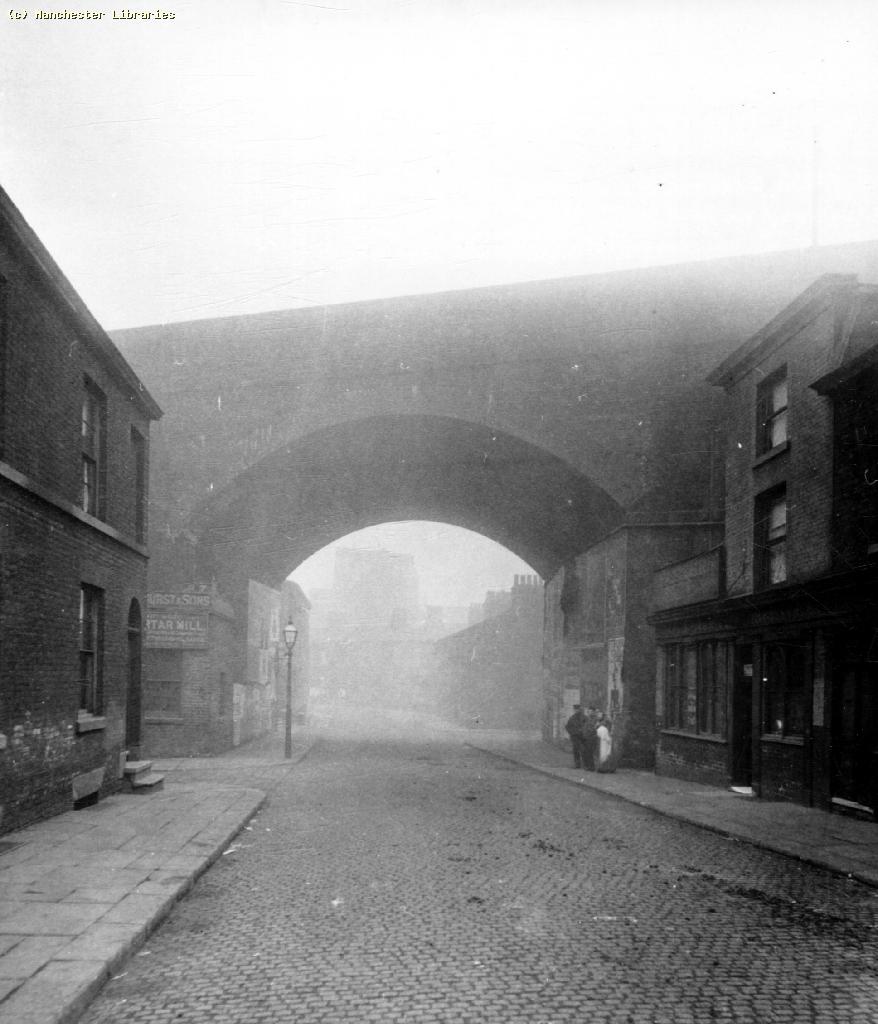
Hoyle Street 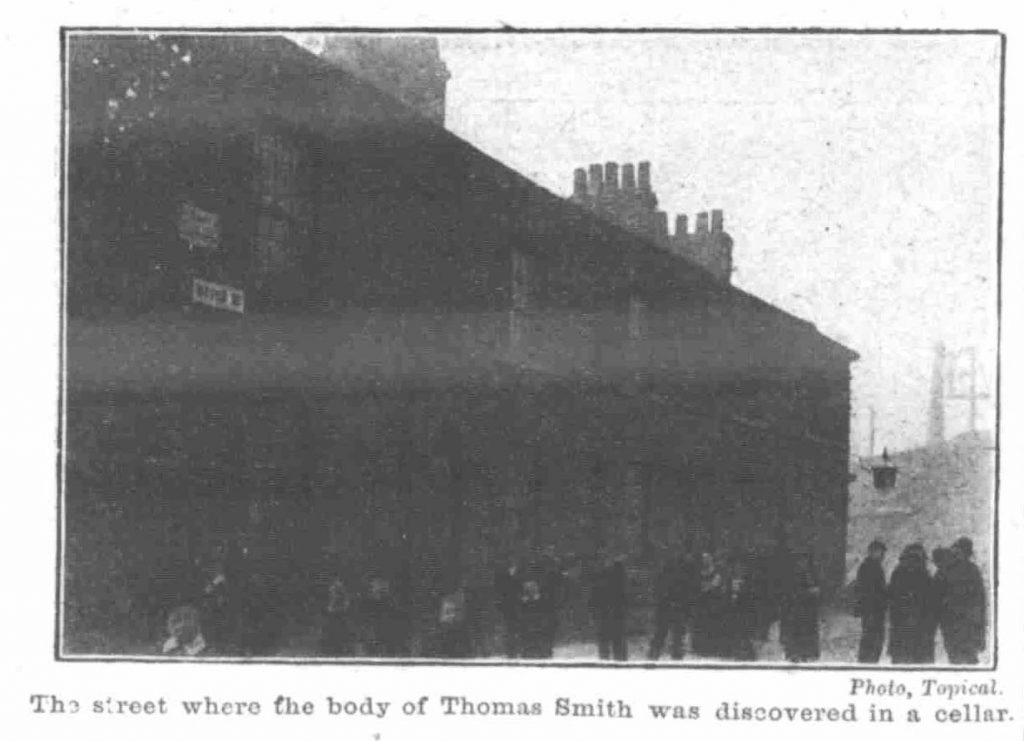
Hoyle Street
Following the report of a body being found by rag and bone man, David Shields; Police Constable Robert Jackson, along with Shields and Harris – made his way to the scene and upon forcing his way into the back yard of the house and reaching the cellar, he noticed a partially clothed body which was lying on its back, feet facing towards a window and the head was placed under a stone slab.
From how cold the body was, PC Jackson assumed it had been there for quite some time. Upon removing the stone slab, he noticed a red handkerchief had been tightly wrapped around the mouth and a brick, slightly stained with blood had been placed onto the neck.
Shocked by the discovery, PC Jackson sent for Superintendent Corden, Detective Sergeant Bloomfield and Detective Holme, as well as the police doctor who all duly arrived some short time later.
On his arrival, Dr. Heslop, after having removed the handkerchief, would soon discover pages of a comic called ‘Funny Cuts’, dated April 8th 1905 stuffed inside the victims mouth as well as severe bruising to the stomach area with the impression of a boot visible to the naked eye, with the heal being more observable than the sole. There were also injuries to the lower part of the body.
By the side of the body a hook was found, and a similar instrument was also found in one of the pockets which were said to have been tools used by the victim at his place of work.
The body was shortly transferred to the Fairfield Street Mortuary where Dr. Heslop himself, would eventually perform the postmortem.
The following day, on Wednesday 12th April, and still worried about the whereabouts of her son Thomas, Mrs. Smith had left her house to do some charring (cleaning) work at her brother-in-law’s house over at Old Trafford. It was when her sister’s husband began reading out the grim details from one of the morning newspapers of a body being found and the description of the deceased that she realized the victim could well be her son.
Without hesitation, she managed to get in touch with Isaac – and accompanied by two friends, they made their way to the mortuary where they would both identify the body. However, the shocking discovery was made even more distressing due to the head having been battered to such an extent they could only identify the body from the cap, scarf, shirt – and more disturbingly, the red handkerchief used to suffocate the boy – as being those worn by her son, Thomas, on the day of his disappearance.
The papers were quick to publish a brief description of the murder with some including in detail the injuries sustained to the victim. This would inevitably lead to talk surrounding the brutal murders that took place 17 years prior, over in Whitechapel, London. The Dublin Evening Mail, Lancashire Evening Post, Western Mail, Sheffield Independent and many more publications would all run with Jack the Ripper comparisons.
As for the inquest, albeit a short one; this would take place on Friday, April 14th. The details of the shocking discovery of the body would be read out and after witnesses such as Mrs. Smith, David Shields, PC Jackson and several other officers had been questioned, and a postmortem had been concluded, the inquest would be adjourned until Friday 5th May.
Over the course of the next two weeks, many police officers, led by Detective Sergeant Bloomfield and Detective Holme on the orders of Superintendent McKenzie, had been instructed to search every house in the nearby neighborhood as well as those that been left abandoned and empty. They would interview hundreds of people in the hope that someone may know something or have heard something relating to the boys murder.
And despite a couple of clues, such as a story of an employer telling a companion whilst drinking in one of the ale houses that one of his boys (employees) had gone on to do an errand for his parents, and whilst out on his journey he met a man who offered him a penny if he would go with him. The lad did go but when he got nearby to an empty house, he remembered his parents telling him not to dally, so he managed to get away from the stranger and made his way back home. A detailed description of the stranger was given to the police but unfortunately no arrest were made.
Another story that perked the interest of the police was that twelve months prior, two separate instances of boys being enticed into empty houses in the same neighborhood had already been reported. An attempt to gag one of the boys resulted in his screams attracting attention and the assailant managed to get away. Again, a detailed description was given to the police but no arrest had been made.
On Friday, 5th May 1905 – the adjourned inquest into the murder of Thomas Smith would resume and opened by the City Coroner, A. E. Gibson. The same witnesses would take to the stand and give their accounts of the days before, during and after Thomas Smith’s body was found.
Mrs. Smith would again speak of the two boys whom had visited her the day after Thomas went missing and evidence was produced in the form of a letter, written by a friend of Mrs. Smith that mentioned Thomas was suffering from ‘face ache’ but he would be returning to work the next morning.
Dr. Heslop would take to the stand and give details of the injuries sustained to Thomas. He would mention how he found the comic forced into the boys mouth after removing the red handkerchief. Mrs. Smith, inconsolable by this point, spoke up saying that the handkerchief had belonged to her son.
However, the most graphic of evidence was yet to come.
Continuing, Dr. Heslop said that the boy’s clothing was torn and disarranged. The trousers were torn apart at the front and pulled down at the back. He face and head where brutally beaten, with bruising clearly apparent. Blood was also coming from the nose and ears. The scalp was beaten to a pulp, giving the doctor no clear sign of an absolute wound.
The was a bruise around the size of a shilling near the corner of the left eye and one over the left cheek about the size of a half a crown. There was also a wound over the nose with another over the left ear.
Another bruise was found near the boys thigh and the doctor concluded this was done with a boot.
On both hands, scratches covered large areas, indicating a struggle had occurred, possibly between the boy and the assailant. The nail on the middle finger from the left hand had also been completely removed.
The doctor would state that death was due to internal bleeding caused by an extensive fracture of the forehead. The Coroner asked if the brick that had been found placed on the boys neck would be the cause of the injuries but Dr. Heslop shook his head and said no.
When further questioned, Dr. Heslop would say that death was almost certainly caused by the use of a life preserver (walking stick) or a similar object with an heavy knob to it.
Thomas had also sustained horrendous mutilations to the lower region of his body. Whoever had committed this act of evil had not only gagged the boy, but also went about torturing him with such ferocity until his death.
As for the brick found on Thomas’s neck, the coroner and doctor concluded this may have simply fallen under the slab accidentally and that was the reason why there was only a trace of blood on it.
A juryman would go on to ask if the body could have been taken to the cellar with the crime being committed elsewhere to which the Coroner would agree, saying that PC Robertson had given evidence to suggest that no struggle had taken place within the cellar.
With very little in terms of finding the culprit responsible for Thomas’s murder and despite hours upon hours of police time and resources being used, Superintendent McKenzie could not give any definite information before the jury as to who the murderer was or how close the police where to capturing the culprit. The jury therefore quickly returned a verdict of willful murder against some person or persons unknown.
The investigation into the murder of Thomas Smith would continue but as the weeks and months went by and with seemingly no clues to follow, things would slowly begin to quieten down. Whilst people went about their daily lives, they would occasionally talk about the murder that took place over on Hoyle Street and with that the perpetrator of the murder would be free to roam the streets of Manchester, poised perhaps, to strike again.
Time would pass and 19 months later and on Tuesday, 20th November 1906, a laborer by the name of William Hulse who was employed to help with the demolition of a row of eight houses on Chapel Street within the Ancoats area of Manchester, would stumble upon an horrific sight.
Upon entering number 6 and having looked around the property, he made his way down into the cellar. With no windows or door connected to this portion of the building and despite the use of a lamp, the cellar was pretty much in complete darkness when Hulse entered it. The first thing that hit him was an awful stench but it was when he began to walk into the cellar, he stumbled over something he couldn’t quite see at first.
Lowering his lamp downwards, the shocking discovery of skeletal remains came into view.
Hulse ran out of the cellar and confronted another workman with whom he had been working alongside and together they went off to seek help.
Police Constable Crowther soon arrived and quickly began investigating the scene. Other officers arrived and when one of them began to prepare the body ready to be taken off to the mortuary, upon lifting it, the head gave way and fell onto the ground. The body was so decomposed that it had to be eventually placed into a bag before being taken away.
The news of the discovery soon made its way through the neighborhood and it quickly became known that it was of a boy, aged around 15 years old and going by the name of Squire Kynaston whose mother, a widow, living in Davis Street, Ancoats would state that she had not seen him ever since he left the home in August owing to having a row over him staying out all night.
She would later say at the inquest that “he had never been a particular good lad” and that he caused her nothing but trouble. He had set fire to their house on one occasion and had stolen money on quite a number of times as well as taken clothing to pawn without her say-so.
The crime scene itself had elements that resembled that of the Thomas Smith murder some 19 months previously at Hoyle Street.
Inspector Watson told the inquest that blood was found to be both on the walls and steps leading into the cellar but these were not like fingerprints. As for the body, a thin strap was found around the neck and this led to some speculation that Kynaston may well have committed suicide due to the fact the strap was loose and not tightened as in the Thomas Smith case. However, this theory was soon dismissed due to the lack of flesh around the neck and Dr. Heslop – City Coroner stating that at the time of death, the strap would indeed have been much tighter. Strikingly, and similar to that of Thomas Smith, a handkerchief was found tied ‘double’ around the boy’s neck.
Also, the lower part of the body was naked, leading the coroner to believe the boy had been outraged, just as was Thomas Smith.
Ultimately, Dr. Heslop could not conclude what the cause of death was due to the advanced state of decomposition. Rats had also eaten large portions of the body, with most of the internal organs gone, including the brain. The skull in this instance had not been fractured leading him to believe Kynaston may well have been strangled.
It seemed that both cases had remarkable parallels. Both victims were young boys and of similar age and both had been found in abandoned houses in the cellars. Both were stripped from the waist down and seemingly outraged. The only difference between the two was that in the Thomas Smith was brutally beaten around the head and face but in the case of Squire Kynaston, the skull had not been fractured.
One police officer was quoted as saying; “Detail by detail, they are exactly the same.“
Had the Manchester Ripper struck again? And if so, why would he wait 19 months to commit another crime?
Well, perhaps the murderer hadn’t waited so long and perhaps he was involved in other cases as it was reported that a few boys did go missing during the months leading up to the Squire Kynaston murder.
One in particular is of interest and took place within walking distance of Hoyle Street and Chapel Street – the scenes of both of the murders we have already discussed. A boy by the name of Richard Burke was just aged 7 years old when he was last seen at London Road Station. T he Manchester Evening News dated Tuesday 5th December 1905 ran a small article describing the boy as being 4ft high with a fair complexion and blue eyes. He was dressed in a navy blue shirt, laced clogs and a grey cap.
Another story written by the same paper appeared on the 2nd December 1905 and mentions the name of John Edward, described as good looking with grey eyes, brown hair and fresh complexion. When he left home he was wearing a brown overcoat, corduroy trousers, grey jacket and laced boots. What is striking about this case though is the boys age – he was 15 years old – around the same age as both Thomas Smith and Squire Kynaston.
Whilst it’s unclear as to what happened to both Richard Burke and John Edward, what we do know is that the Manchester Ripper was never captured. It seems, just like Jack the Ripper, he faded away into the stillness of the night never to face the full punishment of the law, evading capture despite an intensive police investigation.
Perhaps he, or she, did commit other crimes and maybe these may have occurred somewhere other than Manchester. We will never know.
Interestingly, one man was arrested by the police as was reported by the Lancashire Evening Post on Tuesday, 29th August 1905.
It was on the 28th August that John Leonard, a labourer aged 35 years was charged for acting suspicious in the Ardwick area of Manchester. He was seen walking with a boy in the passageway of Hoyle Street where he apparently tried to entice the boy into an abandoned house. The boy managed to run away and when questioned by the police, he told them that the man had a razor, which, upon investigation, a razor was found in the passageway.
Nothing more is known of Leonard or what came of the charges. Could he have been the man responsible for the two murders? Was he released without further charges and then went on to commit the murder of Squire Kynaston? Again, perhaps we will never know.
Thomas Smith’s funeral took place on the 17th April 1905 and his body would be interred within the grounds of Southern Cemetery, Manchester. His grave numbered as 1047.
As for Squire Kynaston, his body would be interred within the grounds of Phillips Park Cemetery, Manchester on the 27th November 1906.
Thank you very much for listening. I hope you enjoyed this story and if you want more please show some support and comment down below. You can follow me on twitter and on instagram – links are down below – but in the meantime, take care and I will be back soon with another tale from the past.
Check out DAFT MONKEY below :
Sources used for this story;
Illustrated Police News – Saturday 01 December 1906
Manchester Evening News – Friday 23 November 1906
Manchester Courier and Lancashire General Advertiser – Friday 23 November 1906
Daily Mirror – Friday 14 April 1905
Lancashire Evening Post – Tuesday 29 August 1905
Nottingham Evening Post – Wednesday 12 April 1905
Manchester Courier and Lancashire General Advertiser – Saturday 06 May 1905
+ many more courtesy of the British Newspaper Archive – www.britishnewspaperarchive.co.uk
Please follow me on social media;
Twitter – https://twitter.com/dohpods
Instagram – www.instagram.com/dohpods

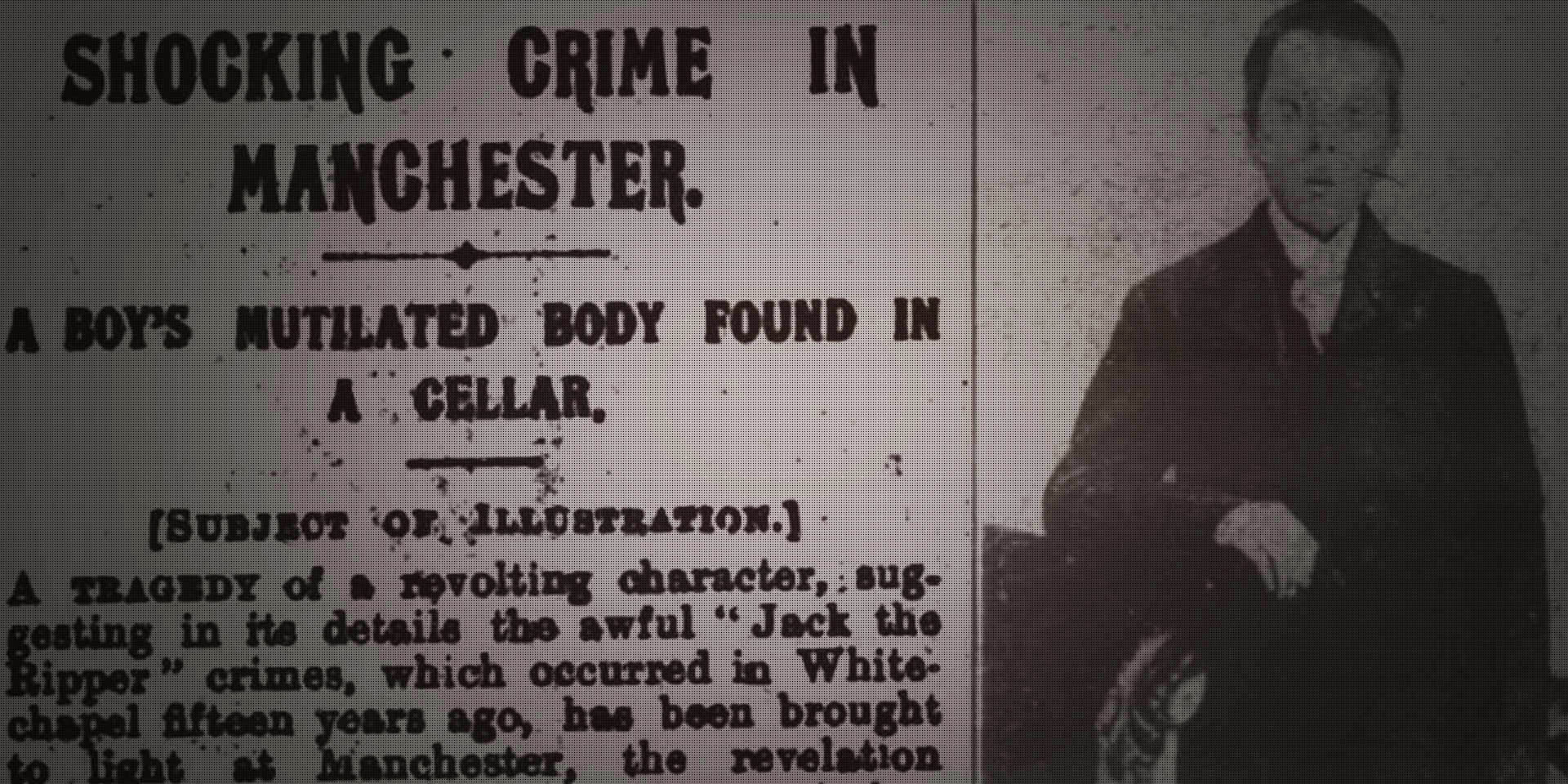

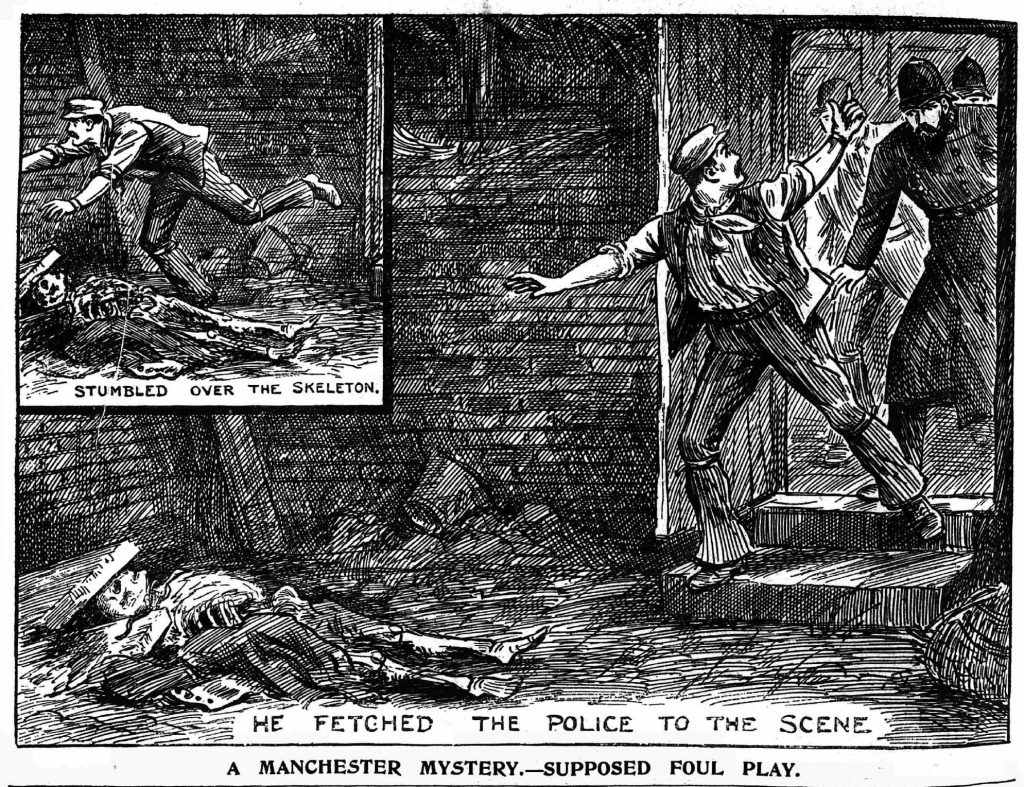
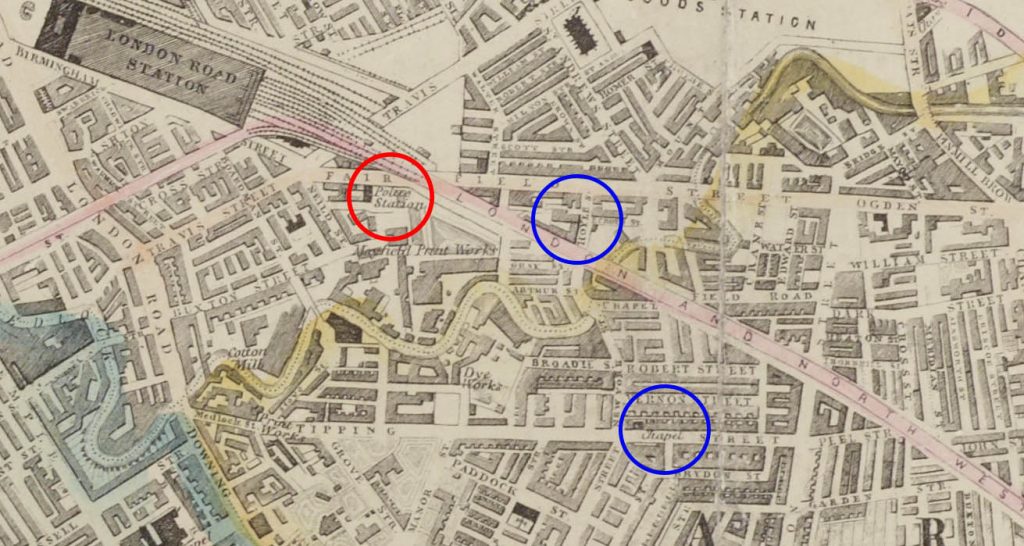

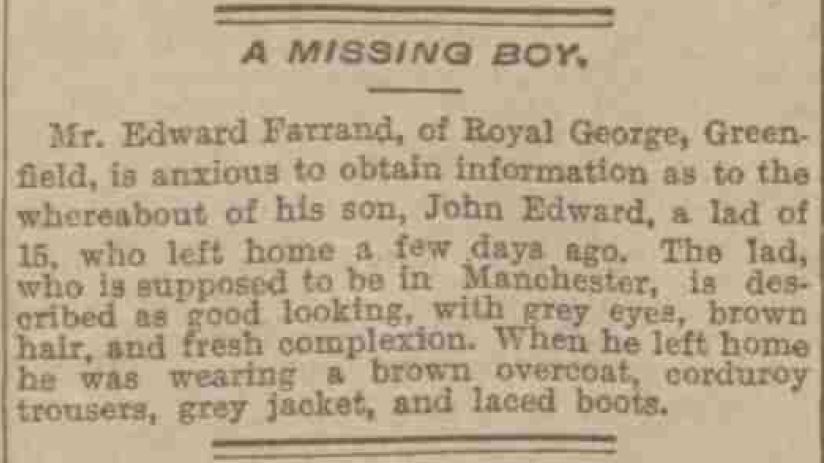
Leave a Reply